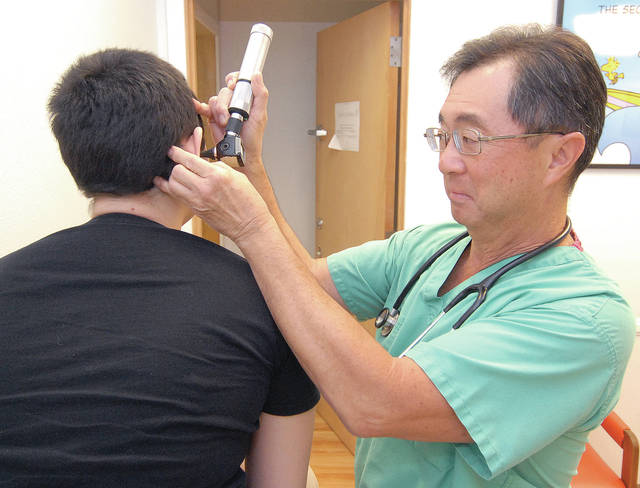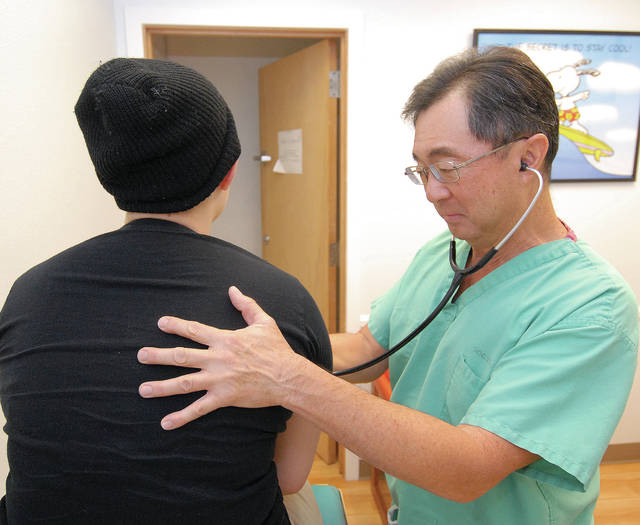KAILUA-KONA — Doctors, politicians and citizens alike concur — medical services on neighbor islands, particularly Hawaii Island, are severely deficient. ADVERTISING KAILUA-KONA — Doctors, politicians and citizens alike concur — medical services on neighbor islands, particularly Hawaii Island, are severely
KAILUA-KONA — Doctors, politicians and citizens alike concur — medical services on neighbor islands, particularly Hawaii Island, are severely deficient.
And the root cause of the system’s affliction is as clear as it is familiar — money. Or, rather, the lack of it.
Nearly all physicians shoulder an onerous burden of a mid-six figure debt accumulated throughout their training, which is harder to pay back in Hawaii, home to the nation’s highest cost of living.
More than 25 percent of the state’s population is on Medicaid and reimbursement totals for primary care physicians, who already make less than specialists, are often incommensurate with other areas across the country.
Medical resources are limited and rural patient populations per physician are staggering. Hawaii also requires a 4 percent sales tax on medical services rendered, which takes another bite out of profit margins.
The list goes on, and the shortages in service providers add up not only to less available care, but also a lower quality of the care that can be found.
“Physicians themselves have become increasingly specialized,” said Richard Creagan, a longtime physician and a state representative for Hawaii Island’s District 5. “So we have a shortage of not only primary care physicians, but we have almost no specialists, and certainly the sub-specialists are not here. Often (they) aren’t even in the state.”
Creagan was one of four experts from across Hawaii who gathered Thursday in West Hawaii at a Community Forums event to discuss the disease plaguing the state’s system, its symptoms and potential treatments.
Josh Green, a state senator representing the Big Island’s District 3 and a practicing emergency room doctor, was a panelist and the moderator at Thursday’s meeting. He said while the percentages of primary care physicians in Hawaii are abysmal, the raw numbers aren’t as bad as they seem because of Hawaii’s modest population.
In Green’s opinion, only 40 or 50 more primary care physicians on Hawaii Island might all but erase issues involving access to care.
For Creagan, the best way to get there is to develop a university teaching hospital in West Hawaii.
Connected to the University of Hawaii at Manoa, which has no teaching hospital, the proposed facility would provide a host of resources currently lacking or completely unavailable on the Big Island. Creagan, in concert with other Hawaii Island legislators, helped secure $500,000 for a viability study of the proposal.
A well-funded teaching hospital would create more opportunities for seasoned physicians. Specialties would be offered, so the numbers of specialty providers would also increase, which would mean less call for patients to fly to Oahu for medical care.
More students would participate in hands-on training in Hawaii, soaking up some of the demand for medical care. And as Green explained Thursday, more training means more retaining.
“If we can get them to either be a medical student here or a resident here for rotations, they tend to stay here,” Green said.
Telemedicine, and even telesurgery, to reach rural populations remotely would also be a key aspect of the facility.
“People that come here often leave because the resources aren’t here,” Creagan said. “They don’t have the back up, they feel isolated and they don’t have people to talk to and to bounce things off of. This (hospital) will be a resource for our current physicians so they may stick around longer.”
Realization of this vision is still years away, if it ever comes, and Creagan said it would require substantial private investment.
Shorter-term solutions involve loan repayment and a stronger reimbursement structure for primary care physicians in Hawaii.
“Loan repayment, from my perspective, is the grand solution,” Green said.
He added $5-$6 million of state funds annually, matched by federal dollars, could take care of loan repayment not only for all primary care physicians, but also all nurse practitioners and all psychologists. The state spends $9 billion on health care every year.
Cary Koike, director of strategic network relations at Hawaii Medical Service Association, said payment transformation for primary care physicians is underway and began with pilot programs in 2016.
“We’re trying to insure that we’re at least on par (with national averages) … if not higher,” Koike said. “Again, though, it’s the same pot of money that we have to (divide) up, so we have to figure out where that’s going to come from.”
Green said studies have shown that interest in primary care increases once average take-home pay hits 70 percent of the average incomes for specialty doctors like radiologists and dermatologists.
Other potential solutions were also discussed Thursday night. One was direct primary care, where patients pay physicians regularly rather than only paying premiums to an insurance company that then decides how to reimburse doctors.
Another involved the idea of visiting physicians, or medical tourism, to soak up some of the demand.
These notions have some glaring disadvantages, however. DPC means more out-of-pocket costs for consumers in a state that already struggles to afford health care and leans heavily on Medicaid.
Medical tourism has inherent licensing issues and Buzz Hollander, a primary care provider who uses a DPC model in Waimea, summed up an even bigger problem with the notion of visiting physicians.
“You want your doctor to live here,” he said.




